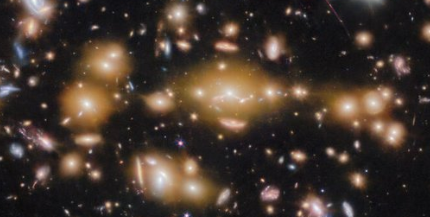Space, the Final Frontier. Like Elon Musk, I can’t wait until humanity is trekking out to the stars. For now, we have to settle for our telescopes and what is being discovered almost daily now.
Not long after the James Webb Space Telescope (JWST) began its science operations, astronomers announced the discovery of galaxies in the early universe that appeared far too large, bright, and full of stars for their age. Headlines around the world sensationalized this by claiming these galaxies were “breaking” our understanding of the Big Bang. However, the truth is much more nuanced and interesting.
The Big Bang theory provides a comprehensive model of the universe’s history, starting from its inception when it was much smaller, hotter, and denser than today. Developed in the early 20th century, this theory has successfully explained various cosmological observations, including the redshift of light from distant galaxies, the cosmic microwave background radiation, the abundances of light elements, and the evolution of galaxies and larger structures.
#UMPlus – Quasar QSO J1131-1231https://t.co/M3hSQz6ptN
This image taken by the James Webb Space Telescope shows quasar QSO J1131-1231 magnified by gravitational lensing. It is…..#astronomy #space #astrophysics #cosmology #astrophotography pic.twitter.com/OWZ74fxSYM— Universo Mágico (@UnivMagicoPlus) July 12, 2024
While the Big Bang theory can’t predict the exact appearance and location of individual galaxies, it can provide statistical probabilities. For instance, cosmologists can estimate the number of small, medium, and large galaxies expected in a given volume at a specific age of the universe. Before JWST, we lacked direct observational access to the earliest stages of galactic evolution, which the telescope was explicitly designed to study.
In 2022, astronomers reported finding extremely distant galaxies that seemed unusually large. These galaxies, with a redshift over 16, indicated they existed just 200 to 250 million years after the Big Bang. They appeared gigantic and fully formed, with spiral arms, which was unexpected for their age.
These findings led to bold headlines proclaiming the death of the Big Bang theory. However, these reports overlooked a crucial detail: the redshift of these galaxies was estimated using photometry, a technique prone to significant uncertainties. A more precise measurement of their redshift was needed to evaluate their impact on cosmology fully.
When these more accurate measurements were obtained, the once record-breaking galaxies turned out to be much more ordinary. For instance, one galaxy’s redshift was revised from over 16 to just 4.9, shifting its age from 240 million years after the Big Bang to well over a billion years—ample time for the Big Bang theory to account for their sizes and shapes.
Astronomers, including Arizona State University Regents and Foundation Professor Rogier Windhorst from @SESEASU, used the James Webb Telescope to detect five young, massive star clusters in a distant galaxy, offering insights into the early universe. https://t.co/QBGUM0aleA pic.twitter.com/urTG0GtgsO
— The College of Liberal Arts and Sciences (@ASUTheCollege) July 9, 2024
Despite these adjustments, new confirmed redshifts for other galaxies, including JADES-GS-z14-0, revealed the current most distant known galaxy with a redshift of 14.32. This galaxy existed when the universe was just 290 million years old. While astronomers expected galaxies to exist 290 million years after the Big Bang, JADES-GS-z14-0’s brightness and star density raise intriguing questions about the early universe’s galaxy formation.
It’s possible that the Big Bang theory could be incorrect, but given the extensive evidence supporting it, a single observation is unlikely to overturn it. JWST was designed to address significant questions about how the first stars and galaxies formed, and it is doing precisely that.
Cosmologists might be able to explain these early galaxies within the Big Bang framework without major revisions. For example, large black holes might have formed before these galaxies, their gravitational pull sparking bright bursts of star formation. Alternatively, supernova feedback and other mechanisms might have made the first galaxies richer in stars than present-day galaxies, making them appear more significant despite their small size. Further observations may reveal more typical galaxies, reducing the current tension with galaxy formation models.
Another possibility is that we may need to add new elements to our understanding of the universe, such as allowing dark energy to evolve over time, to account for these early galaxies.
Breaking records! NASA’s James Webb Space Telescope discovers galaxy GLASS-z13, the most distant galaxy ever observed, shedding light on the early universe’s secrets!#NASA #JamesWebb #Space #Telescope #GLASSz13 #Galaxy #SpaceDiscovery #AwazTV #AwazEnglish #AwazNew pic.twitter.com/iNsJmE8aE2
— Awaz English (@AwazEnglish) July 12, 2024
Key Points:
i. The James Webb Space Telescope has discovered early galaxies that seemed too large and bright for their age, raising questions about the Big Bang theory.
ii. Initial estimates of these galaxies’ redshifts were revised, showing they fit within the expected timeline of the Big Bang theory.
iii. The most distant known galaxy, JADES-GS-z14-0, was confirmed to exist 290 million years after the Big Bang, raising new questions about early galaxy formation.
iv. Possible explanations include early black holes or supernova feedback making initial galaxies star-rich, or the need to evolve our understanding of dark energy.
v. The findings are exciting and drive further exploration and understanding of the universe without necessarily overturning the Big Bang theory.
Fallon Jacobson – Reprinted with permission of Whatfinger News



